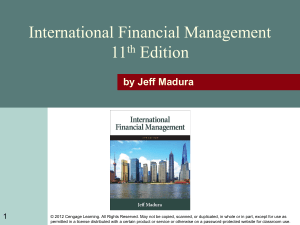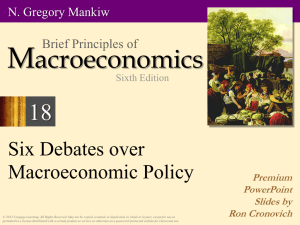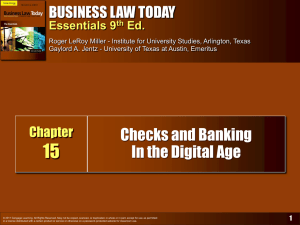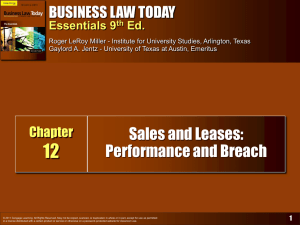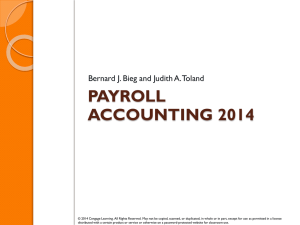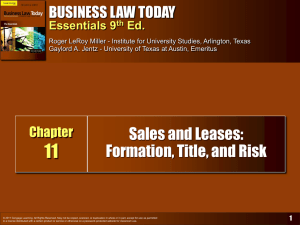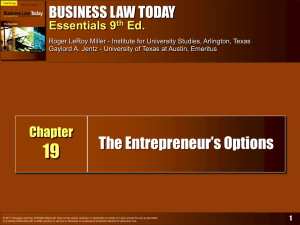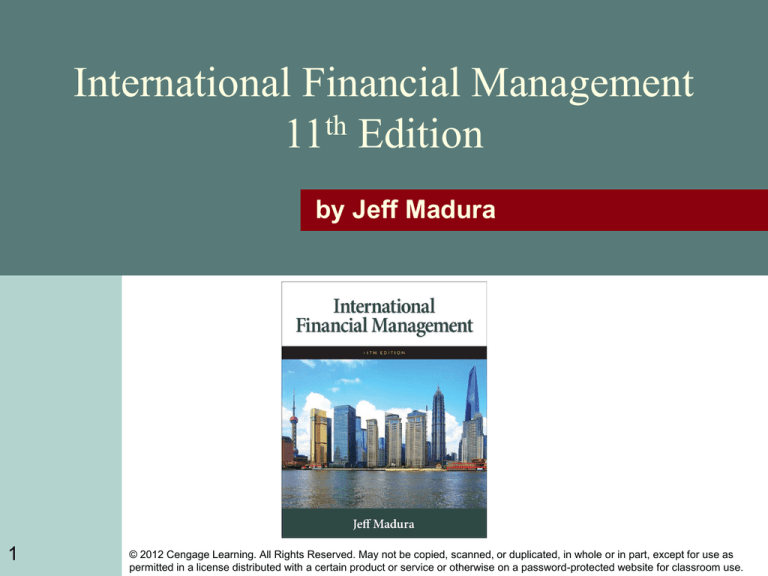
International Financial Management
11th Edition
by Jeff Madura
1
© 2012 Cengage Learning. All Rights Reserved. May not be copied, scanned, or duplicated, in whole or in part, except for use as
permitted in a license distributed with a certain product or service or otherwise on a password-protected website for classroom use.
8
Relationships among Inflation, Interest Rates
and Exchange Rates
Chapter Objectives
Explain the purchasing power parity (PPP) theory and
its implications for exchange rate changes
Explain the International Fisher effect (IFE) theory and
its implications for exchange rate changes
Compare the PPP theory, the IFE theory, and the theory
of interest rate parity (IRP), which was introduced in
the previous chapter
2
© 2012 Cengage Learning. All Rights Reserved. May not be copied, scanned, or duplicated, in whole or in part, except for use as
permitted in a license distributed with a certain product or service or otherwise on a password-protected website for classroom use.
Purchasing Power Parity (PPP)
Interpretations of Purchasing Power Parity
Absolute Form of PPP: without international barriers,
consumers shift their demand to wherever prices are
lower. Prices of the same basket of products in two
different countries should be equal when measured in
common currency.
Relative Form of PPP: Due to market imperfections,
prices of the same basket of products in different
countries will not necessarily be the same, but the rate
of change in prices should be similar when measured
in common currency
3
© 2012 Cengage Learning. All Rights Reserved. May not be copied, scanned, or duplicated, in whole or in part, except for use as
permitted in a license distributed with a certain product or service or otherwise on a password-protected website for classroom use.
Rational Behind Relative PPP Theory
Exchange rate adjustment is necessary for the
relative purchasing power to be the same
whether buying products locally or from
another country.
If the purchasing power is not equal,
consumers will shift purchases to wherever
products are cheaper until the purchasing
power is equal.
4
© 2012 Cengage Learning. All Rights Reserved. May not be copied, scanned, or duplicated, in whole or in part, except for use as
permitted in a license distributed with a certain product or service or otherwise on a password-protected website for classroom use.
Purchasing Power Parity
Relationship between relative inflation rates (I) and the
exchange rate (e).
1 Ih
ef
1
1 I f
Simplified PPP relationship
e f Ih I f
5
© 2012 Cengage Learning. All Rights Reserved. May not be copied, scanned, or duplicated, in whole or in part, except for use as
permitted in a license distributed with a certain product or service or otherwise on a password-protected website for classroom use.
Using PPP to Estimate Exchange Rate Effects
The relative form of PPP can be used to estimate
how an exchange rate will change in response to
differential inflation rates between countries.
International trade is the mechanism by which the
inflation differential affects the exchange rate
according to this theory (Exhibit 8.1)
6
© 2012 Cengage Learning. All Rights Reserved. May not be copied, scanned, or duplicated, in whole or in part, except for use as
permitted in a license distributed with a certain product or service or otherwise on a password-protected website for classroom use.
Exhibit 8.1 Summary of Purchasing Power Parity
7
© 2012 Cengage Learning. All Rights Reserved. May not be copied, scanned, or duplicated, in whole or in part, except for use as
permitted in a license distributed with a certain product or service or otherwise on a password-protected website for classroom use.
Graphic Analysis of Purchasing Power Parity
Using PPP theory, we should be able to assess
the potential impact of inflation on exchange
rates. The points on the Exhibit 8.2 suggest that
given an inflation differential between the home
and the foreign country of X percent, the foreign
currency should adjust by X percent due to that
inflation differential.
PPP Line - The diagonal line connecting all these
points together.
8
© 2012 Cengage Learning. All Rights Reserved. May not be copied, scanned, or duplicated, in whole or in part, except for use as
permitted in a license distributed with a certain product or service or otherwise on a password-protected website for classroom use.
Exhibit 8.2 Illustration of Purchasing Power Parity
9
© 2012 Cengage Learning. All Rights Reserved. May not be copied, scanned, or duplicated, in whole or in part, except for use as
permitted in a license distributed with a certain product or service or otherwise on a password-protected website for classroom use.
Purchasing Power Disparity
Any points off of the PPP line represent
purchasing power disparity. If the exchange rate
does not move as PPP theory suggests, there is a
disparity in the purchasing power of the two
countries.
Point C in Exhibit 8.3 represents a situation
where home inflation (Ih) exceeds foreign
inflation (If ) by 4 percent. Yet, the foreign
currency appreciated by only 1 percent in
response to this inflation differential.
Consequently, purchasing power disparity exists.
10
© 2012 Cengage Learning. All Rights Reserved. May not be copied, scanned, or duplicated, in whole or in part, except for use as
permitted in a license distributed with a certain product or service or otherwise on a password-protected website for classroom use.
Exhibit 8.3 Identifying Disparity in Purchasing
Power
11
© 2012 Cengage Learning. All Rights Reserved. May not be copied, scanned, or duplicated, in whole or in part, except for use as
permitted in a license distributed with a certain product or service or otherwise on a password-protected website for classroom use.
Testing the Purchasing Power Parity Theory
1. Simple tests of PPP (Exhibit 8.4)
Choose two countries (such as the United States and a foreign
country) and compare the differential in their inflation rates to
the percentage change in the foreign currency’s value during
several time periods.
2. Statistical Test of PPP
Apply regression analysis to historical exchange rates and
inflation differentials.
3. Results of Tests of PPP
Deviations from PPP are not as pronounced for longer time
periods, but they still exist. Thus, reliance on PPP to derive a
forecast of the exchange rate is subject to significant error, even
when applied to long-term forecasts.
12
© 2012 Cengage Learning. All Rights Reserved. May not be copied, scanned, or duplicated, in whole or in part, except for use as
permitted in a license distributed with a certain product or service or otherwise on a password-protected website for classroom use.
Exhibit 8.4 Comparison of Annual Inflation Differentials and
Exchange Rate Movements for Four Major Countries
13
© 2012 Cengage Learning. All Rights Reserved. May not be copied, scanned, or duplicated, in whole or in part, except for use as
permitted in a license distributed with a certain product or service or otherwise on a password-protected website for classroom use.
Testing the Purchasing Power Parity Theory (Cont.)
4. Limitation of PPP Tests
Results vary with the base period used. The base period chosen
should reflect an equilibrium position since subsequent periods are
evaluated in comparison to it. If a base period is used when the
foreign currency was relatively weak for reasons other than high
inflation, most subsequent periods could show higher appreciation
of that currency than what would be predicted by PPP.
14
© 2012 Cengage Learning. All Rights Reserved. May not be copied, scanned, or duplicated, in whole or in part, except for use as
permitted in a license distributed with a certain product or service or otherwise on a password-protected website for classroom use.
Why Purchasing Power Parity Does Not Occur
1. Confounding effects
A change in a country’s spot rate is driven by more than the inflation
differential between two countries:
Since the exchange rate movement is not driven solely by ΔINF, the
15
© 2012 Cengage Learning. All Rights Reserved. May not be copied, scanned, or duplicated, in whole or in part, except for use as
permitted in a license distributed with a certain product or service or otherwise on a password-protected website for classroom use.
Why Purchasing Power Parity Does Not Occur
(Cont.)
2. No Substitutes for Traded Goods
If substitute goods are not available domestically,
consumers may not stop buying imported goods.
16
© 2012 Cengage Learning. All Rights Reserved. May not be copied, scanned, or duplicated, in whole or in part, except for use as
permitted in a license distributed with a certain product or service or otherwise on a password-protected website for classroom use.
International Fisher Effect (IFE)
1. The Fisher effect suggests that the nominal
interest rate contain two components:
a. Expected inflation rate
b. Real interest rate
2. The real rate of interest represents the return
on the investment to savers after accounting
for expected inflation.
17
© 2012 Cengage Learning. All Rights Reserved. May not be copied, scanned, or duplicated, in whole or in part, except for use as
permitted in a license distributed with a certain product or service or otherwise on a password-protected website for classroom use.
Using the IFE to Predict Exchange Rate Movements
1. Apply the Fisher Effect to Derive Expected
Inflation per Country
The first step is to derive the expected inflation rates
of the two countries based on the Fisher effect. The
Fisher effect suggests that nominal interest rates of
two countries differ because of the difference in
expected inflation between the two countries.
2. Rely on PPP to Estimate the Exchange Rate
Movement
The second step of the international Fisher effect is to
apply the theory of PPP to determine how the
exchange rate would change in response to those
expected inflation rates of the two countries.
18
© 2012 Cengage Learning. All Rights Reserved. May not be copied, scanned, or duplicated, in whole or in part, except for use as
permitted in a license distributed with a certain product or service or otherwise on a password-protected website for classroom use.
Implications of the International Fisher Effect
1. The international Fisher effect (IFE) theory suggests that
currencies with high interest rates will have high expected
inflation (due to the Fisher effect) and the relatively high
inflation will cause the currencies to depreciate (due to the
PPP effect).
2. Implications of the IFE for Foreign Investors
The implications are similar for foreign investors who
attempt to capitalize on relatively high U.S. interest rates.
The foreign investors will be adversely affected by the
effects of a relatively high U.S. inflation rate if they try to
capitalize on the high U.S. interest rates.
3. Implications of the IFE for Two Non-U.S. Currencies
The IFE theory can be applied to any exchange rate, even
exchange rates that involve two non-U.S. currencies.
19
© 2012 Cengage Learning. All Rights Reserved. May not be copied, scanned, or duplicated, in whole or in part, except for use as
permitted in a license distributed with a certain product or service or otherwise on a password-protected website for classroom use.
Exhibit 8.5 Illustration of the International Fisher Effect (IFE)
from Various Investor Perspectives
20
© 2012 Cengage Learning. All Rights Reserved. May not be copied, scanned, or duplicated, in whole or in part, except for use as
permitted in a license distributed with a certain product or service or otherwise on a password-protected website for classroom use.
Derivation of the International Fisher Effect
1. Relationship between the interest rate (i) differential
between two countries and expected exchange rate (e)
ef
1 ih
1
1 i f
2. Simplified relationship
e f ih i f
3. Summarized in Exhibit 8.6
21
© 2012 Cengage Learning. All Rights Reserved. May not be copied, scanned, or duplicated, in whole or in part, except for use as
permitted in a license distributed with a certain product or service or otherwise on a password-protected website for classroom use.
Exhibit 8.6 Summary of International Fisher Effect
22
© 2012 Cengage Learning. All Rights Reserved. May not be copied, scanned, or duplicated, in whole or in part, except for use as
permitted in a license distributed with a certain product or service or otherwise on a password-protected website for classroom use.
Exhibit 8.7 Illustration of IFE Line (When Exchange Rate
Changes Perfectly Offset Interest Rate Differentials)
23
© 2012 Cengage Learning. All Rights Reserved. May not be copied, scanned, or duplicated, in whole or in part, except for use as
permitted in a license distributed with a certain product or service or otherwise on a password-protected website for classroom use.
Graphic Analysis of the International Fisher Effect
1. Point E in Exhibit 8.7 reflects a situation where the foreign
interest rate exceeds the home interest rate by three percentage
points. The foreign currency has depreciated by 3 percent to
offset its interest rate advantage.
2. Point F represents a home interest rate 2 percent above the
foreign interest rate. IFE theory suggests that the currency
should appreciate by 2 percent to offset the interest rate
disadvantage.
3. Point F illustrates the IFE from a foreign investor’s perspective.
The home interest rate will appear attractive to the foreign
investor. However, IFE theory suggests that the foreign
currency will appreciate by 2 percent.
24
© 2012 Cengage Learning. All Rights Reserved. May not be copied, scanned, or duplicated, in whole or in part, except for use as
permitted in a license distributed with a certain product or service or otherwise on a password-protected website for classroom use.
Graphic Analysis of the International Fisher Effect
1. Points on the IFE Line
All the points along the IFE line reflect exchange rate
adjustments to offset the differential in interest rates. This
means investors will end up achieving the same yield
(adjusted for exchange rate fluctuations) whether they invest
at home or in a foreign country.
2. Points below the IFE Line
Points below the IFE line generally reflect the higher returns
from investing in foreign deposits.
3. Points above the IFE Line
Points above the IFE line generally reflect returns from
foreign deposits that are lower than the returns possible
domestically.
25
© 2012 Cengage Learning. All Rights Reserved. May not be copied, scanned, or duplicated, in whole or in part, except for use as
permitted in a license distributed with a certain product or service or otherwise on a password-protected website for classroom use.
Tests of the International Fisher Effect
What Can be Tested
If the actual points (one for each period) of interest rates and
exchange rate changes were plotted over time on a graph, we
could determine whether
the points are systematically below the IFE line (suggesting
higher returns from foreign investing),
above the line (suggesting lower returns from foreign
investing), or
evenly scattered on both sides (suggesting a balance of higher
returns from foreign investing in some periods and lower
foreign returns in other periods).
Statistical Test of the IFE
26
Apply regression analysis to historical exchange rates and the
nominal
interest
differential.
© 2012 Cengagerate
Learning.
All Rights Reserved. May not be copied, scanned, or duplicated, in whole or in part, except for use as
permitted in a license distributed with a certain product or service or otherwise on a password-protected website for classroom use.
Exhibit 8.8 Illustration of IFE Concept (When Exchange Rate
Changes Offset Interest Rate Differentials on Average)
27
© 2012 Cengage Learning. All Rights Reserved. May not be copied, scanned, or duplicated, in whole or in part, except for use as
permitted in a license distributed with a certain product or service or otherwise on a password-protected website for classroom use.
Limitations of the IFE
The IFE theory relies on the Fisher effect and PPP
1. Limitation of the Fisher Effect
The difference between the nominal interest rate and actual
inflation rate is not consistent. Thus, while the Fisher effect can
effectively use nominal interest rates to estimate the market’s
expected inflation over a particular period, the market may be
wrong.
2. Limitation of PPP
Other country characteristics besides inflation (income levels,
government controls) can affect exchange rate movements.
Even if the expected inflation derived from the Fisher effect
properly reflects the actual inflation rate over the period,
relying solely on inflation to forecast the future exchange rate is
subject to error.
28
© 2012 Cengage Learning. All Rights Reserved. May not be copied, scanned, or duplicated, in whole or in part, except for use as
permitted in a license distributed with a certain product or service or otherwise on a password-protected website for classroom use.
IFE Theory versus Reality
1. The IFE theory contradicts how a country with a high
interest rate can attract more capital flows and therefore
cause the local currency’s value to strengthen (Ch 4).
2. IFE theory also contradicts how central banks may
purposely try to raise interest rates in order to attract
funds and strengthen the value of their local currencies
(Ch 6).
3. Whether the IFE holds in reality is dependent on the
countries involved and the period assessed.
4. The IFE theory may be especially meaningful to
situations in which the MNCs and large investors consider
investing in countries where the prevailing interest rates
are very high.
29
© 2012 Cengage Learning. All Rights Reserved. May not be copied, scanned, or duplicated, in whole or in part, except for use as
permitted in a license distributed with a certain product or service or otherwise on a password-protected website for classroom use.
Comparison of the IRP, PPP, and IFE
Although all three theories relate to the determination of
exchange rates, they have different implications.
IRP focuses on why the forward rate differs from the spot
rate and on the degree of difference that should exist. It
relates to a specific point in time.
PPP and IFE focus on how a currency’s spot rate will
change over time.
Whereas PPP suggests that the spot rate will change in
accordance with inflation differentials, IFE suggests that it
will change in accordance with interest rate differentials.
PPP is related to IFE because expected inflation
differentials influence the nominal interest rate differentials
between two countries.
30
© 2012 Cengage Learning. All Rights Reserved. May not be copied, scanned, or duplicated, in whole or in part, except for use as
permitted in a license distributed with a certain product or service or otherwise on a password-protected website for classroom use.
Exhibit 8.9 Comparison of the IRP, PPP, and IFE Theories
31
© 2012 Cengage Learning. All Rights Reserved. May not be copied, scanned, or duplicated, in whole or in part, except for use as
permitted in a license distributed with a certain product or service or otherwise on a password-protected website for classroom use.
SUMMARY
Purchasing power parity (PPP) theory specifies a precise
relationship between relative inflation rates of two
countries and their exchange rate. In inexact terms, PPP
theory suggests that the equilibrium exchange rate will
adjust by the same magnitude as the differential in
inflation rates between two countries. Though PPP
continues to be a valuable concept, there is evidence of
sizable deviations from the theory in the real world.
32
© 2012 Cengage Learning. All Rights Reserved. May not be copied, scanned, or duplicated, in whole or in part, except for use as
permitted in a license distributed with a certain product or service or otherwise on a password-protected website for classroom use.
SUMMARY (Cont.)
The international Fisher effect (IFE) specifies a
precise relationship between relative interest rates of
two countries and their exchange rates. It suggests
that an investor who periodically invests in foreign
interest-bearing securities will, on average, achieve a
return similar to what is possible domestically. This
implies that the exchange rate of the country with
high interest rates will depreciate to offset the interest
rate advantage achieved by foreign investments.
However, there is evidence that during some periods
the IFE does not hold. Thus, investment in foreign
short-term securities may achieve a higher return than
what is possible domestically.
33
© 2012 Cengage Learning. All Rights Reserved. May not be copied, scanned, or duplicated, in whole or in part, except for use as
permitted in a license distributed with a certain product or service or otherwise on a password-protected website for classroom use.
SUMMARY (Cont.)
The PPP theory focuses on the relationship between the
inflation rate differential and future exchange rate
movements. The IFE focuses on the interest rate
differential and future exchange rate movements. The
theory of interest rate parity (IRP) focuses on the
relationship between the interest rate differential and the
forward rate premium (or discount) at a given point in
time.
34
© 2012 Cengage Learning. All Rights Reserved. May not be copied, scanned, or duplicated, in whole or in part, except for use as
permitted in a license distributed with a certain product or service or otherwise on a password-protected website for classroom use.


